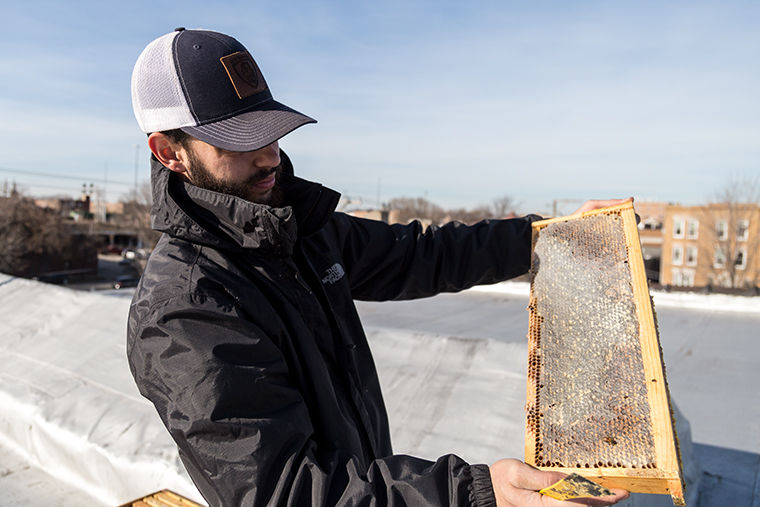‘Honey, I’m home’—Bees find hive in Bridgeport
November 27, 2017
Growing up in Indiana, Raymond Tominello was surrounded by agriculture and farming. When he moved to Chicago, he wanted to bring a little bit of home with him, so he created Rooftop Local Honey in 2015.
Tominello has five beehives, holding up to 50,000 bees, on a Bridgeport rooftop. It is the source of his product line of honey and honey-based products, which he sells at Hardscrabble Gifts, 3335 S. Halsted St., and Joy Cafe, 258 W. 31st St.
Tominello said he plans to expand the business and house beehives at various downtown locations on rooftops.
“I saw a good opportunity to offer honey to people around the city,” Tominello said. “Especially being in the city, you don’t get local honey because most people have bees outside the city.”
Tominello is one of several rooftop beekeepers in Chicagoland. Thad Smith—manager of West Side Bee Boyz, which manages hives and produces honey throughout Chicago—said the urban environment is great for beekeepers because many people keep gardens and plants in the city on their rooftops and windowsills.
“If you have a house, plant some flowers that will bloom in the spring, summer and fall,” Smith said. “That is the greatest thing you can do, as far as helping the bee population.”
Although beekeepers flourish in Chicago, the national bee population declined across all known bee species by 23 percent between 2008 and 2013, as reported Sept. 19, 2016, by The Chronicle.
As of April 1, the number of commercial honeybee colonies rose 3 percent from the previous year, according to an Aug. 1 U.S. Department of Agriculture honeybee survey.
“[With] not enough food [and] issues around pesticides, there are a number of pests, pathogens and diseases bees get,” said Denise Ellsworth, program director of the Department of Entomology at Ohio State University. “All of these factors come together and compound the health of honeybees, bumblebees and other pollinators.”
Along with maintaining bees, Tominello said he plans to partner with Chicago schools to teach children about bees.
“If you go to a school in the city, you don’t really get taught [about bees],” Tominello said. “It will help if we get kids to focus on [bees] and off the streets. [They] can focus on something that is cool and will benefit everyone.”
Despite the general public knowing the bee population is declining, Ellsworth said most people are unaware of why it is a serious problem. Bees are major natural pollinators, and 80 percent of our food crops depend on those kind of animal pollinators, she said.
“It would be a very boring diet if we didn’t have animal pollinators,” Ellsworth said.
With honeybees providing honey and native bees pollinating crops, Smith said it is important to inform others about bees’ contributions and to plant flowers to help save the insect population.
“We need to make sure that we take care of the native bee population as well as the honeybee,” Smith said. “When you go outside, remember that bee can save your grandchild’s life.”








